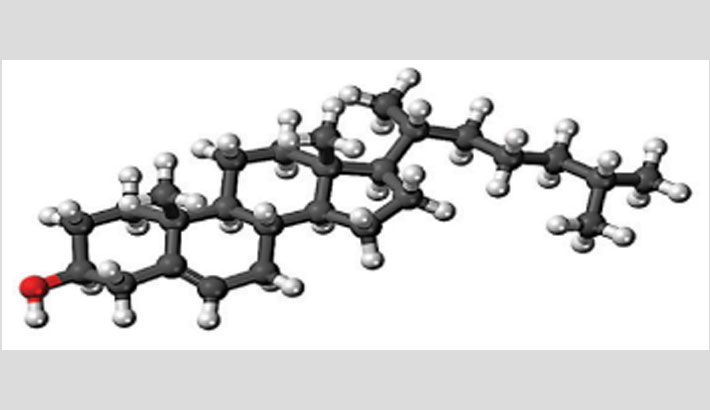Cholesterol: A Nutrient Of Concern | Abdullah Al Moinee

Cholesterol: A Nutrient Of Concern
Abdullah Al Moinee
[ www.daily-sun.com/post/210771/Cholesterol:-A-Nutrient-Of-Concern ]
The term “cholesterol” is derived from the Greek khole or “bile” (as in “cholera”) and sterops or “solid, stiff” (as in “sterility”). Francois Pelletier de la Salle first discovered cholesterol in solid form in gallstones in 1769. It was named “cholesterol” in 1815 by chemist Eugene Chevreul.
Cholesterol is a type of lipid that is essential for all life in the proper amount. Our bodies need healthy levels of cholesterol to function. Cholesterol is a fatty substance made by the liver and distributed throughout the body. It helps to make the outer coating of cells and produces the bile acids to digest food in the intestine. It allows the body to make Vitamin D and hormones. If a person’s cholesterol level were 0 (an impossibility), his cell membranes would be dry and cracked and all the cell content would leak out. Researchers suggest that cholesterol plays a vital role in neuron signaling and brain structure. Approximately 1-2 in 9,000 babies is born with a birth defect related to the fetus’ failure to make the cholesterol it needs. Besides the better a person copes with the stress, the higher his “good” cholesterol levels are.
High cholesterol means we have a lot more cholesterol in our blood than we need. Most people who have high cholesterol don’t have any obvious symptoms. A simple blood test can tell us if we have high cholesterol. If we do have high cholesterol, dietary changes, exercise, and targeted medications can help lower it and reduce our risk of developing heart disease.
Cholesterol is carried in the blood in miniscule protein particles called lipoproteins. The smallest particles are called High Density Lipoproteins (HDL) and these particles actually protect against heart disease which pump up as much excess cholesterol as it can and takes it back to the liver. The intermediate size ones are called Low Density Lipoprotein (LDL) which carries cholesterol from our liver to the cells around our body where it’s needed. But if the level of LDL in blood is too high, it can form fatty deposits in arteries. The job of the arteries is to move blood from our heart to other parts of our body. Too much LDL and not enough HDL makes it more likely that our arteries will develop plaque, a hardened mixture of cholesterol, fat, and other elements. When coronary arteries narrow due to plaque, it’s harder for blood to make it through to our heart. If an area of plaque breaks open, it can result in a blood clot, which can block blood flow altogether. This puts us at great risk of having a heart attack.
Symptoms of reduced blood supply to the heart include chest discomfort and pressure. We may also have pain in our jaw, neck, shoulders, arms, or back.
If blood circulation to one section of heart muscle is blocked, the result is a heart attack. That means the heart muscle is dying. Blood flow has to be restored fast, or there’s a risk of permanent heart damage or death. When plaque builds up in the arteries that carry blood to our brain, our brain is deprived of oxygen. Brain cells then quickly become damaged and start to die which leads to a stroke. Symptoms include sudden weakness and numbness. Depending on the area of the brain involved, we may have trouble speaking, seeing, or moving our limbs. A stroke can cause brain damage, disability, or death. Plaque can also build up and interfere with blood flow to our arms and legs (peripheral arterial disease). If the blood supply to our limbs is blocked, we may feel numbness or pain. There’s an increased risk of infection in those limbs. Lack of blood can cause tissue death (gangrene). High cholesterol can create a bile imbalance, leading to gallstones.
The American Heart Association recommends a maximum intake of 300 mg. of cholesterol per day for those who have normal levels. Those who already have high cholesterol should eat no more than 200 mg. per day. While eggs are lower in cholesterol than previously thought, one large chicken egg still contains about 185 mg of cholesterol, all of which is contained in the yolk. While liver is an iron-rich food, it is also high in cholesterol. In fact, the most concentrated levels of cholesterol in animal meats are found in organ meats like the liver. The most effective way to lower LDL cholesterol is to limit the amount of saturated fat and follow a healthy diet. It’s important to substitute foods that contain unhealthy, saturated and trans-fats such as egg yolks, fish oils, fast foods (fries & burgers), liver, shrimp, red meat, sausages, butter, ghee, margarine, cheese, muffins, cakes & pastries, tobacco, palms etc with foods that contain polyunsaturated and monounsaturated fats such as vegetable oils, peanuts, almonds, garlic, whole barley, dark chocolate, green tea, beans, okra, oats, eggplants, apples, strawberries, grapes, avocados and so on.
Our body is a delicate combination, so we must take proper care of our health. We should also be careful about the intake of cholesterol with a view to escalating our health to equilibrium.
Moinee, A. Al. “Cholesterol: A nutrient of Concern” The Daily Sun. 7(136). 9 Mar. 2017. The Hood. 6(52).Moinee, A. Al. “Cholesterol: A nutrient of Concern” The Daily Sun 9 Mar. 2017. The Hood. 6(52).
